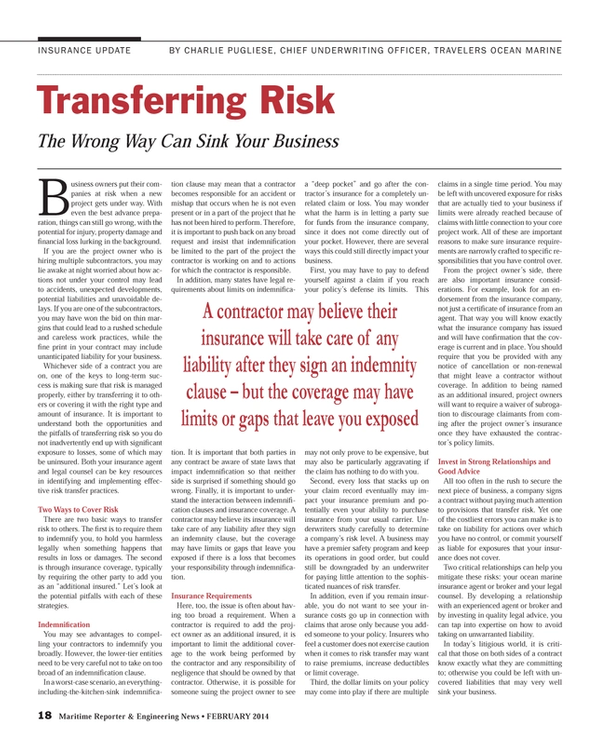
Transferring Risk for Long-term Success
Business owners put their companies at risk when a new project gets under way. With even the best advance preparation, things can still go wrong, with the potential for injury, property damage and financial loss lurking in the background.
If you are the project owner who is hiring multiple subcontractors, you may lie awake at night worried about how actions not under your control may lead to accidents, unexpected developments, potential liabilities and unavoidable delays. If you are one of the subcontractors, you may have won the bid on thin margins that could lead to a rushed schedule and careless work practices, while the fine print in your contract may include unanticipated liability for your business.
Whichever side of a contract you are on, one of the keys to long-term success is making sure that risk is managed properly, either by transferring it to others or covering it with the right type and amount of insurance. It is important to understand both the opportunities and the pitfalls of transferring risk so you do not inadvertently end up with significant exposure to losses, some of which may be uninsured. Both your insurance agent and legal counsel can be key resources in identifying and implementing effective risk transfer practices.
Two Ways to Cover Risk
There are two basic ways to transfer risk to others. The first is to require them to indemnify you, to hold you harmless legally when something happens that results in loss or damages. The second is through insurance coverage, typically by requiring the other party to add you as an “additional insured.” Let’s look at the potential pitfalls with each of these strategies.
Indemnification
You may see advantages to compelling your contractors to indemnify you broadly. However, the lower-tier entities need to be very careful not to take on too broad of an indemnification clause.
In a worst-case scenario, an everything-including-the-kitchen-sink indemnification clause may mean that a contractor becomes responsible for an accident or mishap that occurs when he is not even present or in a part of the project that he has not been hired to perform. Therefore, it is important to push back on any broad request and insist that indemnification be limited to the part of the project the contractor is working on and to actions for which the contractor is responsible.
In addition, many states have legal requirements about limits on indemnification. It is important that both parties in any contract be aware of state laws that impact indemnification so that neither side is surprised if something should go wrong. Finally, it is important to understand the interaction between indemnification clauses and insurance coverage. A contractor may believe its insurance will take care of any liability after they sign an indemnity clause, but the coverage may have limits or gaps that leave you exposed if there is a loss that becomes your responsibility through indemnification.
Insurance Requirements
Here, too, the issue is often about having too broad a requirement. When a contractor is required to add the project owner as an additional insured, it is important to limit the additional coverage to the work being performed by the contractor and any responsibility of negligence that should be owned by that contractor. Otherwise, it is possible for someone suing the project owner to see a “deep pocket” and go after the contractor’s insurance for a completely unrelated claim or loss. You may wonder what the harm is in letting a party sue for funds from the insurance company, since it does not come directly out of your pocket. However, there are several ways this could still directly impact your business.
First, you may have to pay to defend yourself against a claim if you reach your policy’s defense its limits. This may not only prove to be expensive, but may also be particularly aggravating if the claim has nothing to do with you.
Second, every loss that stacks up on your claim record eventually may impact your insurance premium and potentially even your ability to purchase insurance from your usual carrier. Underwriters study carefully to determine a company’s risk level. A business may have a premier safety program and keep its operations in good order, but could still be downgraded by an underwriter for paying little attention to the sophisticated nuances of risk transfer.
In addition, even if you remain insurable, you do not want to see your insurance costs go up in connection with claims that arose only because you added someone to your policy. Insurers who feel a customer does not exercise caution when it comes to risk transfer may want to raise premiums, increase deductibles or limit coverage.
Third, the dollar limits on your policy may come into play if there are multiple claims in a single time period. You may be left with uncovered exposure for risks that are actually tied to your business if limits were already reached because of claims with little connection to your core project work. All of these are important reasons to make sure insurance requirements are narrowly crafted to specific responsibilities that you have control over.
From the project owner’s side, there are also important insurance considerations. For example, look for an endorsement from the insurance company, not just a certificate of insurance from an agent. That way you will know exactly what the insurance company has issued and will have confirmation that the coverage is current and in place. You should require that you be provided with any notice of cancellation or non-renewal that might leave a contractor without coverage. In addition to being named as an additional insured, project owners will want to require a waiver of subrogation to discourage claimants from coming after the project owner’s insurance once they have exhausted the contractor’s policy limits.
Invest in Strong Relationships and Good Advice
All too often in the rush to secure the next piece of business, a company signs a contract without paying much attention to provisions that transfer risk. Yet one of the costliest errors you can make is to take on liability for actions over which you have no control, or commit yourself as liable for exposures that your insurance does not cover.
Two critical relationships can help you mitigate these risks: your ocean marine insurance agent or broker and your legal counsel. By developing a relationship with an experienced agent or broker and by investing in quality legal advice, you can tap into expertise on how to avoid taking on unwarranted liability.
In today’s litigious world, it is critical that those on both sides of a contract know exactly what they are committing to; otherwise you could be left with uncovered liabilities that may very well sink your business.
(As published in the February 2014 edition of Maritime Reporter & Engineering News - www.marinelink.com)
Read Transferring Risk for Long-term Success in Pdf, Flash or Html5 edition of February 2014 Maritime Reporter
Other stories from February 2014 issue
Content
- Something Old, Something New ... page: 06
- Floating Production Market Forecast page: 10
- The FLNG Market is Poised for Growth page: 12
- Managing BWT Costs and Compliance page: 14
- U.S. Coast Guard Must Assert its Authority page: 16
- Transferring Risk for Long-term Success page: 18
- You Can Run, But You Can’t Hide page: 24
- Cruise Industry Poised for Global Growth page: 26
- MIOX Safe Water Management for Cruise Ships page: 28
- Five Minutes With Tomas Tillberg page: 30
- SS United States: Leading Lady to Damsel in Distress page: 32
- Alfa Laval: Green & Efficient Shipping page: 42
- Oily Wastewater Transformed with WETT-O page: 45
- Siemens System Controls Filter Biofouling page: 46
- New BWM Regs Cometh - Are you ready? page: 46
- Valve Train Halves Idle to Full Load Time page: 48
- Unmanned Ships Now a Reality page: 49
- Five Minutes with WSS's Simon Hutt page: 50
- Hempel Debuts Hempaguard page: 54
- Ecofix Corrosion Repair with Ecoshield Application page: 54
- Envelop Protective Covers page: 55
- GAC Launches Eco-friendly Hull Cleaning Solution page: 56
- CS Unitec Debuts Trelawny Floor Planer page: 56
- New Hatch Sealing Tape page: 57
- New Aluminum Vise Action Compression Latch page: 57
- High Strength, Vibration Resistant Fastener from Huck page: 57
- Gumdrop Debuts Cases for Marine Industry page: 57
- New Handheld Marking System FlyMarker PRO page: 57
- Viking Refits Four NGSCO Vessels with LRRS System page: 57
- DNV GL Debuts New Explosion Hazard Software page: 57
- Handy, Quick Legionella Tests for Cruise Ships page: 58
- AMSOIL Introduces New Arctic Synthetic Grease page: 58
- Clean Marine to Supply EGCS for Tanker Newbuilds page: 58
- Engineered Ventilation Systems Keep Engine Rooms Humming page: 58
- New FARO Laser Scanner Focus3D X 33 page: 58


